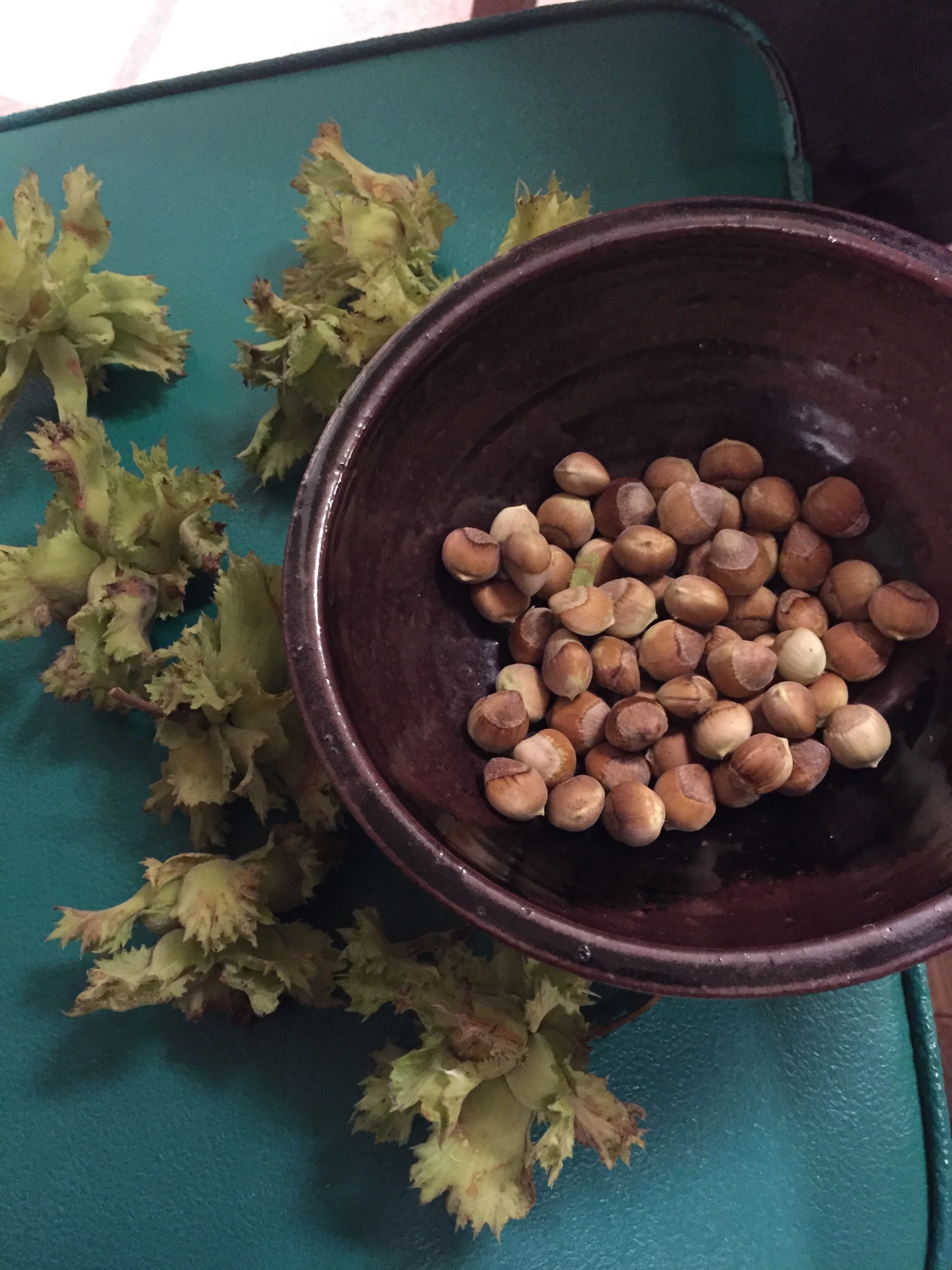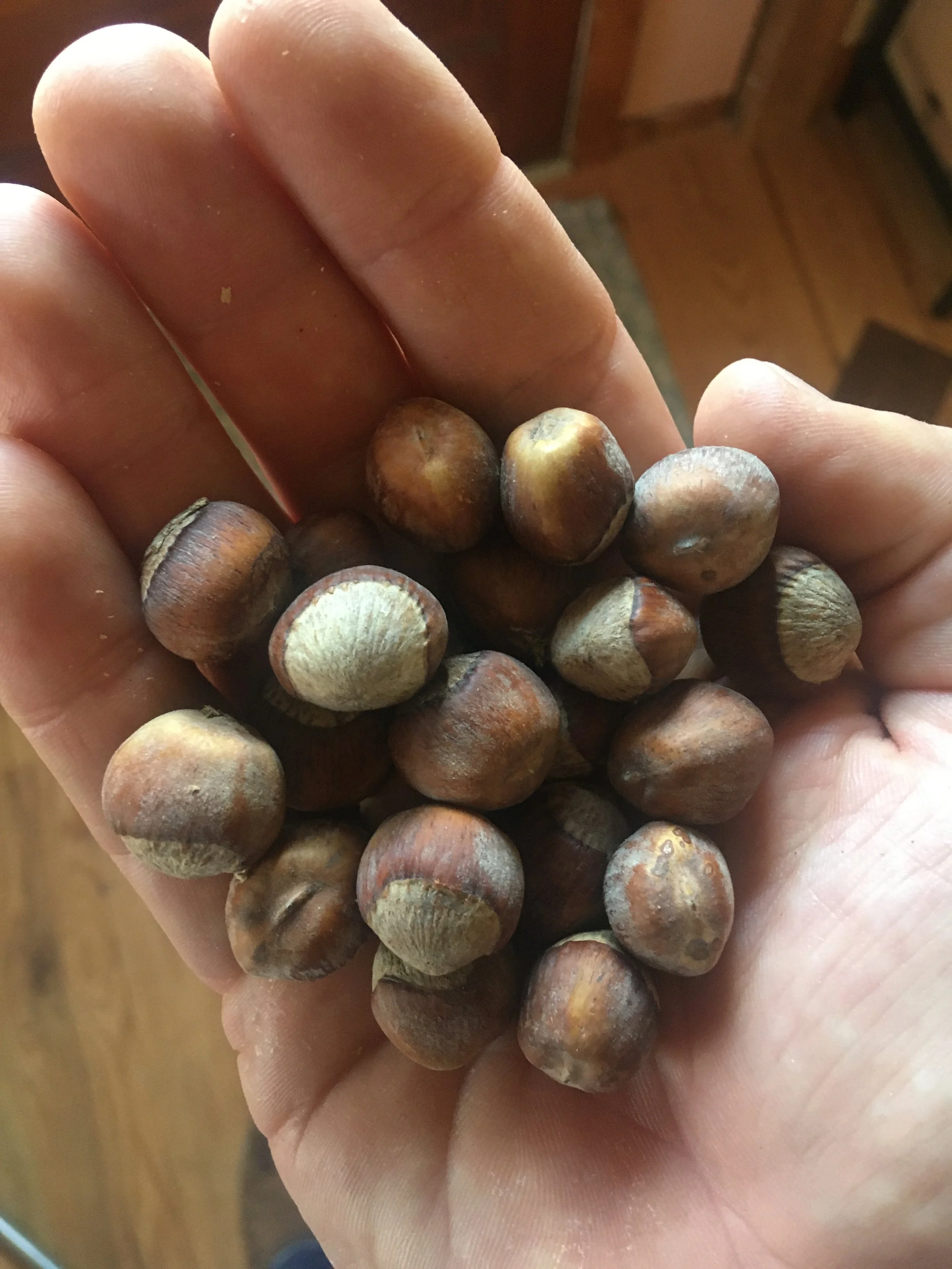Hazelnut







Hazelnut
Corylus spp.
Plant for nutritious nuts and soybean oil, for ancient coppice crafts, and for divine waterway thickets!
Hardy from Zones 4-9. 15-18 feet tall, 10-12 feet wide. Plant a few buddies to make sure they live up to their fertile mythology.
Good ole hardy heart-warming Hazel. This shrub is a Birch family member, native all over the Eastern Woodlands of North America with nearly twenty Corylus cousins spread across Europe and western Asia, from Britain to Greece and Turkey, where they’re grown extensively for nut production. The species readily hybridize, pollinated by the wind, so distinguishing can sometimes be challenging. Studies of pollen suggest that Hazel spread over large parts of Europe nearly 9,000 years ago. Archaeologists found thousands of 8,000-year old burned hazelnut shells in a shallow midden (or dump) pit on a Scottish island.
Nutella didn’t discover the flavorful nutrition. Hazel often embodied fertility in old cultures: English sweethearts gained good luck under the bows and Roman weddings were scented with Hazel torches to summon fecundity. The mythic lore of Hazel is as rich as the kernel. In many European fairy tales, Hazel branches provide protection in the forest understory. Celtic teachings treated Hazel as a giver of wisdom. In fact, one of the greatest Gaelic heroes, Finn McCumhaill, got his legendary start by accidentally and indirectly eating hazelnuts. Nine Hazels grew around a sacred pool feeding the Salmon of Knowledge with their mast. Whoever ate the fish flesh was said to digest all the world’s knowledge and poetic language. An old poet named Finnegas waited and watched at the Well of Wisdom for seven years, finally catching the hallowed fish for his young student Finn to cook, instructing the lad not to eat any himself. But Finn got a blister from the dripping fat and sucked on his thumb to cool it down, sucking in some of the fish juices at the same time. And with that the Hazel knowledge that had passed to the Salmon passed to Finn. Finnegas saw the light in Finn’s eyes, realizing that the fish was really meant for the boy, and encouraged Finn to eat the rest of the meal to feed his future of battle glory and poetic prominence.
Wonderful traditions grow like thickets everywhere Hazel does in Native America. A biodiverse array of Indigenous ethnobotanical knowledge matches the brilliance of that Celtic Hazel-lined pool and its Salmon of Knowledge. Iroquoian cultures like Cherokee and Haudenosaunee, Siouan tribes like Lakota, and Algonquian people like Ojibwe (or Chippewa) have partnered with Hazel for millennia to conjure up culinary delights and medicinal applications. Recipes include fresh nuts with honey for Winter storage or ground-up nutmeats mixed with cornmeal and berries for puddings, breads, or boiling nuts into an oily drink which served as a gynecological aid. The oil also warded off mosquitoes when blended with bear grease. Boiling the bracts with Bur Oak inner oak and sprinkling in dark soil and Butternut oil yields a black dye. Inner bark remedies encourage vomiting when necessary while other bark decoctions soothe teething babies and twig and leaf infusions ease aching gastrointestinal systems.
We fill late Summer buckets and baskets with the mast that also feeds squirrels, deer, turkey, woodpecker, and many others. Native American Hazel usually produces smaller nuts, sometimes called cobnuts, than European cultivars, but they produce a lot after a few years from seed and sweetens soups no matter the size. They’re excellent raw, but roasted nuts are even better in breads and cakes or ground into a creamy buttery spread. Nuts are high in Vitamin E and fats, calcium and protein, and even olives don’t have as much oleic acid. The oil is a major reason agricultural research groups like the Savanna Institute are stoked about hazelnuts, which they called “soy on trees” because hazelnuts have a higher caloric and oil yield than conventional soybeans. The nuts are 50-75% oil and 90% monounsaturated fats, which can lower risks for blood pressure and coronary heart disease. Plus, it’s a tasty cooking oil that stores well, and the presscake can still be ground into flour.
Nuts grow in two stiff enveloping leaves called involucres, whorls of bracts that look like little full beards, which might be the origin of the common name Filbert, though the more likely origin is St. Philbert, whose feast falls near the traditional hazelnut harvest. The scientific name Corylus descends from the Latin word for helmet or hood. Catkins form in warm Summer and overwinter on angled twigs like pale yellow tinsel, opening over 200 flowers throughout late Winter and early Spring. Puffs of pollen ride the wind to tiny bright red styles flowering from green buds. Hazels are monoecious, meaning both these flowers blossom on the same plant. Botanically speaking, Hazels can be self-fertile, but catkins rarely fertilize flowers on the same plant because the blossoming times don’t align. Some varieties are actually self-incompatible because flowers go through hormonal changes when opening so they can’t be self-pollinated as an adaptation to prevent inbreeding. That’s why growers often cultivate nut-producing cultivars and specific pollinizers bred to partner with them. However, a good mix usually does the trick for a full hefty harvest.
Hazel dwells well in the company of woodlands and fertile easily-drained loams in riparian zones. They tolerate a pretty wide range of soil types and pH, and while they can stand shade they’ll produce more and larger nuts in the open. Several species of Lepidoptera love the leaves (and deer will eat them too if you’re not careful), turning sunlight into copious carbon. An acre of Hazelnut can sequester over one ton of carbon into their woody bodies during their first five years of life. Long tangling rhizomatic root systems build fertility and prevent erosion.
Suckering into thickets easily establishes a Hazel coppice, a traditional woodland tended by the art of coppicing: sustainably cutting a tree or shrub to the ground to encourage new reddish shoots, which are cut on rotation for firewood, craftwood, and ecological restoration by thinning overstory to shine light onto the forest floor. Woodworkers turn the firm flexible rods – gray-brown on the outside, smooth white-grained on the inside – into baskets, drumming sticks, portable fencing, waddle-and-daub buildings, pea and bean poles, artist charcoal, hedge-laying, and dowsing rods for water diviners. Hazel is remarkably agile, circling back on itself without snapping. Tip the stems down to the ground, hold them in place with a rock or stake, and they’ll root! In a way, coppicing embodies Hazel’s fertile mythology by making the plants nearly immortal.
We propagate two diverse selections of Hazelnuts:
Hybrid Hazelnut (Corylus avellana x americana): a large category includes a wide range of crosses of Corylus species. We hand-harvest ripe nuts in September from a university grove planted in 1994 with selections from Oregon State University’s ongoing Hazelnut breeding program for eastern filbert blight resistance and kernel size. Most US commercial hazelnuts come from the Pacific Northwest. At that time, OSU cultivated 20 selections of Native Hazelnuts and European Filberts with two named cultivars (‘Lewis’ and ‘Clark’), all of which had some susceptibility to the blight, which is caused by a fungus that lives on Native Hazelnuts. However, the grove we gather in produces prolifically every year with no signs of blight damage. Native Hazel harbors the blight but isn’t threatened by it. Nut size varies, but overall harvest is abundant. The five remaining shrubs are suckering and densely planted. We mix seed together and have been very pleased with the results!
Native Hazelnut (Corylus americana): lovely large nuts on tall healthy plants in wild thickets on our roadside and a neighboring farm. Excellent for ecological restoration and agroforestry plantings, and we’re selecting more intentionally from these for local breeding efforts that we’re playfully starting to name ‘Kazlenuts,’ stirring up the species name with our place name.